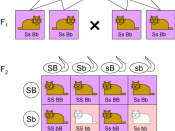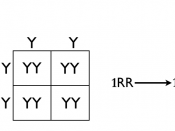Introduction:Drosophila is a fruit fly, a little insect about 3mm long, of the kind that accumulates around spoiled fruit. It is also one of the most valuable organisms in biological research, particularly in genetics and developmental biology. Drosophila has been used as a model organism for research for almost a century, and today, several thousand scientists are working on many different aspects of the fruit fly. The first method is the monohybrid cross which a punnet square can be used to identify the genotype of the cross. The second method is a sex linked cross which identifies the phenotypic expression of an allele that is related to the gender of the individual and is found on the sex chromosomes. This mode of inheritance is in contrast to the inheritance of traits on autosomal chromosomes, where both sexes have the same probability of expressing the trait. The third method is the dihybrid cross which is the progeny of a cross between homozygous parents differing in two species.
A homozygous parent has two copies of the same gene. There are two types of homozygous, either dominant or recessive. Homozygous dominant is two dominant alleles, and homozygous recessive is two recessive alleles on the same gene. A heterozygous parent has two different alleles that constantly produce unlike gametes, one allele is dominant and the other allele is recessive. The recessive allele can be a mutant because an altered form of the wild type must have risen from a mutation. A wild type can either be homozygous dominant or heterozygous dominant.
In this experiment on Drosophila the parental cross was observed. The parental was homozygous dominant sepia (se+/se+) with homozygous recessive sepia (se/se). The parental cross that was observed was one hundred percent heterozygous dominant sepia. The F1 progeny that was crossed was heterozygous...


